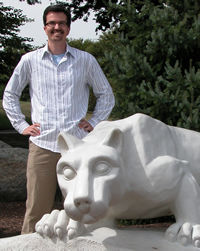Biography
Dr. Timothy Lawlor received a B.S. in Mathematics from Pennsylvania State University, a B.S. in Physics from East Stroudsburg University, an M.S. in Physics from Wichita State University and a Ph.D. in Physics from The University of Delaware.
Dr. Lawlor conducts research in computational stellar astrophysics using the ‘Cambridge Code,’ also referred to the ‘Eggleton Code’ after its original authorship in the early 1970’s. His papers have been published in Monthly Notices of the Royal Astronomical Society and the Astrophysical Journal. These papers included work on outbursting stars such as Sakurai’s Object (V4334 Sgr), sometimes referred to as ‘Born-again’ stars because of their sudden brightening over only weeks. He also models Population III stars, the first metal free stars to form during the early universe, over a large range of masses.
Dr. Lawlor has been involved in astronomy education and public outreach and has supervised a number of undergraduate research projects in both astronomy and physics. Students are invited to contact Dr. Lawlor to explore their interests in physics and astronomy.
Media inquiries are welcome about stellar astronomy or general astronomy events such as eclipses, comets, transits, or any interesting thing in the sky throughout the year. Inquiries are also welcome from researchers in astrophysics who may have use for stellar evolution models.
Select Publications
T.M. Lawlor & J. MacDonald, 2023, "Evolution of low mass population III stars from the pre-main sequence to the white dwarf cooling track," Monthly Notices of the Royal Astronomical Society, 525, 4700–4716
T. M. Lawlor, 2023, "A closer look at low-mass post-AGB late thermal pulses," Monthly Notices of the Royal Astronomical Society, 519, 5373–5383
T.M. Lawlor, 2021, "New models for the rapid evolution of the central star of the Stingray Nebula,"
Monthly Notices of the Royal Astronomical Society, 504 (1), 667-677
T. M. Lawlor & T. Niiler, 2020, "Physics Textbooks from 1960–2016: A History of Gender and Racial Bias," The Physics Teacher, Vol. 58, pp..320-323, May 2020
T.M. Lawlor, T.R. Young, J. Teffs, J. MacDonald, 2015, "The effects of convection criteria on the evolution of population III stars and the detectability of their supernovae", Monthly Notices of the Royal Astronomical Society, 450(2), 1618-1630
J. MacDonald, T.M. Lawlor, N. Anilmis, and N.F. Rufo, 2013 “The extremely low metallicity star SDSS J102915+172927: a subgiant scenario,” Monthly Notices of the Royal Astronomical Society, (May 11, 2013) 431 (2), 1425-1431
T.M. Lawlor, 2013, “Astronomy Exercises for the Artist: Van Gogh the Observer,” Astronomy Education Review, 12, 010202 (2013)
T.M. Lawlor, 2010 “The Early Universe Stars: A Review and Modeling Results for Population III Stars,” Penn State York Smith Symposium, 7, November 2010
T.M. Lawlor, T.R. Young, T.A. Johnson & J. MacDonald, 2008, “Evolution Populations III stars and their Supernova Explosions,” Monthly Notices of the Royal Astronomical Society, 384, 1583
T.M. Lawlor & J. MacDonald, 2006, “The Mass of Helium in White Dwarf Stars and the Formation and Evolution of Hydrogen Deficient Post-AGB Stars,” Monthly Notices of the Royal Astronomical Society, 371, pp. 263-282.
T.M. Lawlor, 2005, “A New Model for V838 Mon: A Born-again Object with an Episode of Accretion,” Monthly Notices of the Royal Astronomical Society, 361, pp. 695-700.
T.M. Lawlor & J. MacDonald, 2003, “Sakurai’s Object, V605 Aquilae, and FG Sagittae: An Evolutionary Sequence Revealed,” Astrophysical Journal, 583, pp. 913-922.
